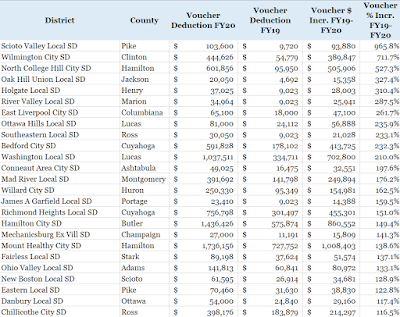One of the remnants of House Bill 1 -- the landmark school funding and policy legislation during which I served as Chairman of the Primary and Secondary Education Subcommittee of the House Finance and Appropriations Committee -- was a provision that required all EdChoice voucher students to be tested the same as public school students.
This provision has allowed for there to be several years of testing data for some EdChoice students. The results are only posted if a certain number of students at a private school take vouchers. And only the EdChoice students at the private schools take the tests.
However, it is useful, I feel, to compare how students taking vouchers do vs. those who do not. The results are interesting. But there are several caveats:
- The test results for voucher students only calculate the proficiency rate. Nothing on student growth. And nothing about how much over proficiency the students score. For example, public school students can rate Proficient, Accelerated or Advanced. But all voucher students get is whether they are proficient.
- There are no test results for students in private schools who do NOT take a voucher. So the results I'm about to discuss do NOT necessarily indicate how the privates are doing overall. It is simply measuring how voucher recipients do and how proficient they are on state tests.
So here's how I did this comparison using 2017-2018 school year data (the latest available), given the caveats:
- I looked at all private schools eligible to take EdChoice vouchers and sorted them by mailing address, then averaged their performance by that community. So, for example, I looked at the average proficiency rate of EdChoice students in private schools with a Cleveland mailing address.
- I then compared their overall proficiency rate with the rate of proficient or better scoring students in the public school district that contains the private, voucher school. So all EdChoice students in private schools with a Cleveland mailing address compared with the proficiency rate of all Cleveland Municipal School District students.
- In cases where more than one district covered the city listed in the voucher school address, I compared the proficiency scores for the voucher school (or schools) with the lower performing district that covered that private school
- In cases of major urban areas (Akron, Canton, Cincinnati, Columbus, Cleveland, Dayton, Toledo and Youngstown), I compared all the private voucher schools' performance with those mailing addresses with the major urban districts'. It should be noted, though, that several of these private schools are NOT in the major urban cities. They are in suburbs, but have mailing addresses in the major urban core. But I wanted to be as conservative as possible in this comparison.
Here's what I found:
- Of the 139 school districts that contain private schools taking EdChoice vouchers, 109 had better proficiency rates than the voucher schools. That means that 78% of the time, the public school district students outperformed the private school voucher students in the same community
- The average difference was 27 percentage points (for example, the difference between being 50% proficient and 77% proficient) -- a massive difference
- The average difference between districts that underperformed voucher buildings was a relatively paltry 9%. So districts outperformed voucher buildings at 3 times the scale of voucher buildings outperforming districts.
- Overall, the average proficiency rate in the public school district was 63.5%. The average proficiency rate for an EdChoice building was 44.4%
These data are especially important now that more than 7 in 10 Ohio school districts have at least one building eligible to have students take the EdChoice voucher.
In nearly 8 of 10 cases, that student's choice to take a voucher will result in the voucher student attending a school where they are less likely to do well on state tests than the public building they left.
Given EdChoice supporters' claims that the program "rescues" kids from "failing public schools", one would think this data would give them pause. But we've known this for years -- that EdChoice does not improve student performance; it harms student achievement.
So we'll see if this new data changes any minds.



















